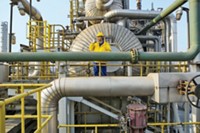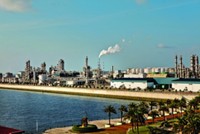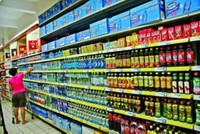Advertisement
Grab your lab coat. Let's get started
Welcome!
Welcome!
Create an account below to get 6 C&EN articles per month, receive newsletters and more - all free.
It seems this is your first time logging in online. Please enter the following information to continue.
As an ACS member you automatically get access to this site. All we need is few more details to create your reading experience.
Not you? Sign in with a different account.
Not you? Sign in with a different account.
ERROR 1
ERROR 1
ERROR 2
ERROR 2
ERROR 2
ERROR 2
ERROR 2
Password and Confirm password must match.
If you have an ACS member number, please enter it here so we can link this account to your membership. (optional)
ERROR 2
ACS values your privacy. By submitting your information, you are gaining access to C&EN and subscribing to our weekly newsletter. We use the information you provide to make your reading experience better, and we will never sell your data to third party members.
Business
Marketing Singapore
Government of island nation strives to expand industrial development
by WILLIAM G. SCHULZ, C&EN WASHINGTON
April 4, 2005
| A version of this story appeared in
Volume 83, Issue 14

Since 1961, the singapore economic Development Board (EDB)--a government body established by the Republic of Singapore--has had the singular challenge of convincing foreign investors that the island nation is a good place to do business.
The challenges have been formidable. In 1961, Singapore had a per capita gross national product of about $320; it was a developing country with almost no natural resources of its own. Infrastructure was poor, there was little capital, and what industry existed produced goods only for local consumption.
But with a population of some 3 million people, Singapore did have labor. A chain of uninhabited small islands just off its coastline was a place where companies might locate a variety of manufacturing operations.
When Singapore, a former British colony, declared independence from Malaysia in 1965, EDB staff opened offices in Hong Kong and New York City and set about marketing the young country to a variety of industries, including the chemical industry.
Today, Singapore has a population of more than 4 million people. It is well-known for its aggressive, probusiness climate--"Singapore Inc.," the saying goes.
It is also a strict law-and-order society. The U.S. State Department reports significant restrictions on freedom of speech, freedom of the press, and other civil and political rights. Caning--a type of flogging with a rattan whip that inflicts deep wounds and excruciating pain--is the punishment meted out for more than 30 crimes in Singapore.
But the economy of Singapore is diverse and open, and the country has a standard of living that matches other nations in the developed world. It boasts a literacy rate of 100%, and to many people from other parts of the world, it is considered a good place to live and work.
Manufacturing accounted for about 28% of Singapore's 2004 gross domestic product of $106 billion. Within the manufacturing sector is what EDB calls the "chemicals cluster"--mainly petroleum, petrochemicals, and specialties. The cluster, in turn, makes up 28% of the country's manufacturing sector.
The EDB chemicals cluster director is Aw Kah Peng, a Massachusetts Institute of Technology-trained chemical engineer. She is one of several EDB directors who are trying to further diversify Singapore's economy. The country was hard hit by the 2001–03 global recession, which saw a decline in manufacturing. But officials such as Peng are working hard to build an economy more diverse and thus more immune to such global economic spasms. She met with C&EN in Washington recently to discuss Singapore and issues related to further developing the chemical industry there.
"We have numerous offices overseas--seven are located here in North America. In our work, we spend a lot of time with companies," Peng says. "We talk to them to understand what industry is about, what industry will need in order for it to continue to grow."
According to EDB figures, the Singapore chemicals cluster saw 29% growth in output last year, and the profitability of companies in the chemicals sector increased by 46%. Peng attributes such growth to the high demand for these companies' products and stronger prices throughout 2004. "I think it was the combination of those two factors that helped output to grow," she says.
GROWTH has been tempered by energy costs. "We also saw the impact of higher crude prices," Peng says. "But because it is a competitive market, competition helps to keep some of that in balance. We don't have any oil or gas reserves, so most of our fuel is imported."
Most of Singapore's oil, she adds, comes from the Middle East, while natural gas comes from Indonesia and Malaysia.
"The single largest drawback for the chemical and refining industry in Singapore is the lack of indigenous resources for feedstocks," says Mark Lashier, Asian region manager for Chevron Phillips Chemical.
Asked about access to markets, Peng points out that logistics is one of Singapore's strengths. "We are right in the middle of the shipping routes. Logistics is what we consider to be one of the core advantages of Singapore. It should come as no surprise that it's the busiest container port in the world in terms of tonnage that passes through the port."
Along with logistics and infrastructure, Peng says Singapore has become known for the quality of its workforce, "especially for industries where you don't need a lot of people but you need the right people."
Another strength, she says, is protection of intellectual property. "We police and enforce, but we also teach people about intellectual property." She says the government recognizes the importance of this issue to industry today and has worked hard to make intellectual property concerns a nonissue.
Peng points out that Singapore has also been developing a network of free-trade agreements. "This is relatively new because we started working at it about five to six years ago. In fact, one of the first agreements we had was the Singapore-U.S. trade agreement signed two years ago," Peng says. "We also have free-trade agreements with Japan, Australia, New Zealand, non-European Union countries in Europe, and other countries in Asia."
Asked about competition from China, she says, "First of all, we compete globally. We have to compete globally because every investment opportunity that comes along--sometimes they will look at Singapore versus China, sometimes they will look at Singapore versus the Gulf Coast, sometimes Singapore versus Rotterdam. China will then be just one on a list of our potential competitors."
Peng seems particularly proud of industrial development on Jurong Island. "It had been seven small islands, which we amalgamated through a land reclamation process and then enlarged further," she says. "This was a fairly massive project, and it cost the government almost $4 billion. On some of that land there were already oil refineries from the 1960s."
Today, there are about 80 chemical firms operating on Jurong Island, including most of the industry's top names: ExxonMobil, Chevron Phillips, Shell Chemicals, BASF, DuPont, Invista, Eastman--the list goes on. ExxonMobil is considering building another cracker in Singapore (C&EN, March 14, page 14), and so is Shell.
IN THE PAST, there were anecdotal reports that operating in Singapore could mean difficulty in finding parts to operate manufacturing plants and the qualified people to run them. But Peng says Jurong Island is now home to many companies in the business of providing parts and other plant-operating services. "The chemical industry is very important to Singapore, and we are committed to helping it grow," she says.
Chevron Phillips' Lashier confirms this. "The EDB is very accessible, and we maintain close contact with them," he says.
There are many supports in place for industry once companies have located in Singapore, Peng says. She lists benefits like tax incentives, grants to train people, grants to conduct R&D, and support for setting up business offices or headquarters.
Peng says Singapore is also trying to build R&D capacity specifically for the needs of industry. "EDB comes under the Ministry of Trade & Industry. There is another body under the same ministry that is called the Agency for Science, Technology & Research. We call them A-STAR for short. They work very closely with EDB to build up the R&D infrastructure.
"Late last year we finished building the Institute of Chemical & Engineering Sciences on Jurong Island. It was opened last year, and there are about 100 researchers now. These are people who have been working for the industry for a long time--10 to 15 years. Some of their core programs are catalysis and synthesis. They have already signed some research agreements with industry."





Join the conversation
Contact the reporter
Submit a Letter to the Editor for publication
Engage with us on Twitter